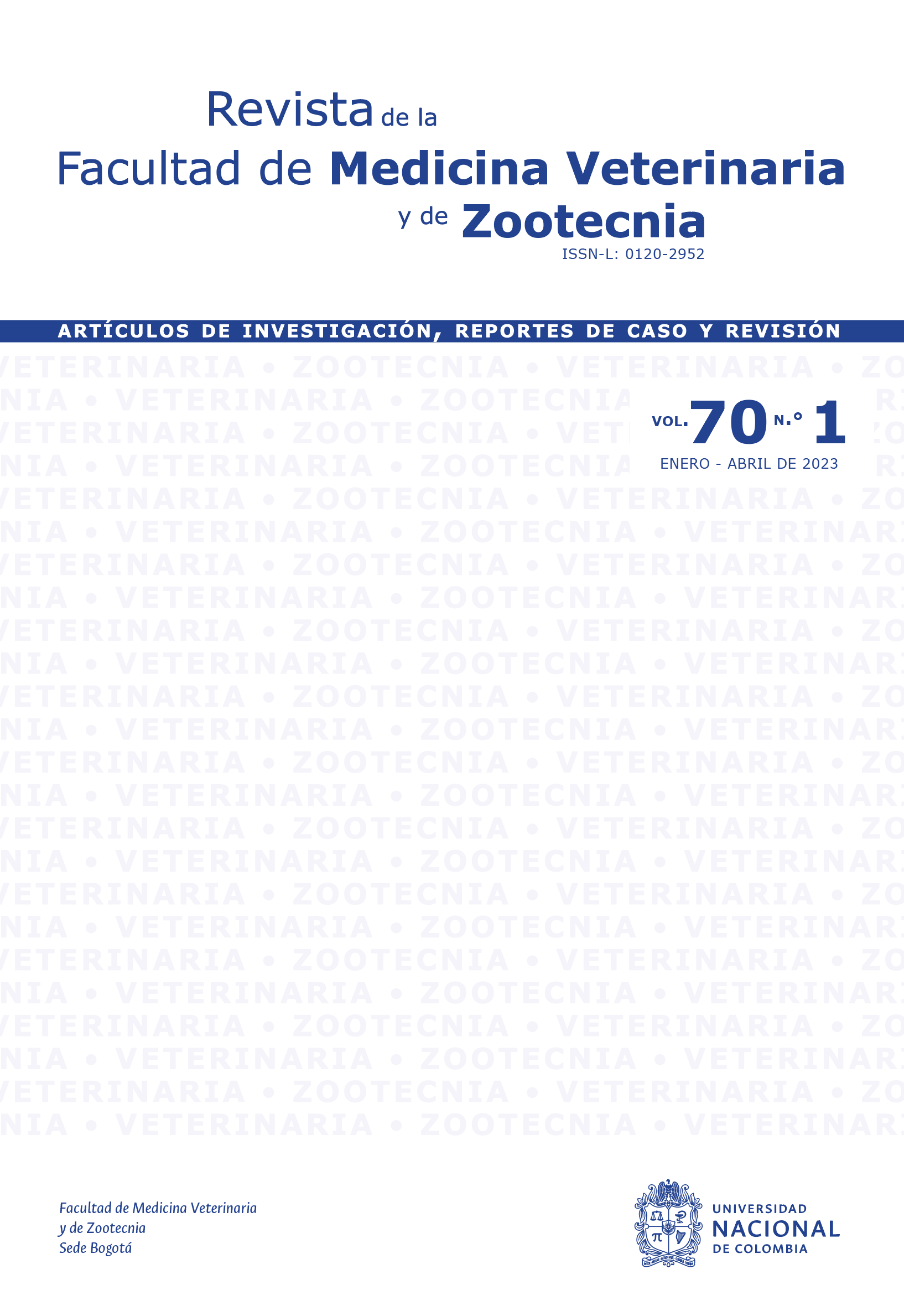Frecuencia de calicivirus en felinos con signos respiratorios en Medellín, Colombia (2020)
Frequency of calicivirus in felines with respiratory signs in Medellin, Colombia (2020)
DOI:
https://doi.org/10.15446/rfmvz.v70n1.100373Palabras clave:
calicivirus felino, conjuntivitis, RCP, úlcera oral (es)conjunctivitis, feline calicivirus, oral ulcer, PCR (en)
Descargas
Resumen
El calicivirus felino (CVF) es uno de los principales patógenos infectivos que causan la enfermedad del tracto respiratorio superior en gatos (ETRS). Es un virus de presentación común en gatos en condiciones de albergue o gatos con acceso al exterior, el cuadro clínico está asociado con sintomatología respiratoria, ulceraciones orales, secreción ocular y cojeras. El objetivo de este estudio fue determinar la frecuencia de calicivirus felino en animales con cuadro respiratorio en la ciudad de Medellín, Colombia, en 2020. Se realizó un estudio descriptivo de corte transversal donde se incluyeron 64 gatos domésticos con sintomatología compatible con enfermedad del tracto respiratorio superior y úlceras orales para determinación de frecuencia de presentación de CVF, la distribución fue 36 hembras y 28 machos y la raza mestiza fue la más frecuente con 47 ejemplares, los cuales fueron vacunados con vacuna convencional cepa F9. Se realizaron hisopados conjuntivales y nasales para diagnóstico por reacción en cadena de la polimerasa (RCP) para detección de calicivirus felino, de los cuales 22 gatos resultaron positivos a calicivirosis felina, con una frecuencia del 34,3% de la muestra evaluada. El calicivirus felino es una enfermedad de alta frecuencia de presentación en los felinos domésticos con sintomatología respiratoria y con úlceras orales en Medellín, Colombia, inclusive en gatos vacunados con vacunas convencionales que contienen la cepa F9, lo que puede implicar que están circulando cepas que no responden a estas vacunas.
Abstract
Feline calicivirus (FVC) is one of the main infectious pathogens causing upper respiratory tract disease in cats (URTD). It is a virus of common presentation in cats in shelter conditions or cats with access to the outside, the clinical picture is associated with respiratory symptoms, oral ulcerations, eye discharge, and lameness. To determine the frequency of feline calicivirus in animals with respiratory symptoms in Medellín, Colombia, in 2020, a descriptive cross-sectional study was carried out, including 64 domestic cats with signs compatible with upper respiratory tract disease and oral ulcers. For determination of the frequency of presentation of FVC, the distribution was 36 females and 28 males, and the mestizo race was the most frequent with 47 specimens, which were vaccinated with conventional vaccine strain F9. Conjunctival and nasal swabs were performed for diagnosis by polymerase chain reaction (PCR) to detect feline calicivirus, of which 22 cats were positive for feline calicivirosis, representing a frequency of 34.3% of the sample evaluated. Feline calicivirus is a disease with a high frequency in domestic felines with respiratory symptoms and oral ulcers in Medellin, Colombia, including cats vaccinated with conventional vaccines containing the F9 strain, which may imply that strains that do not respond to these vaccines are circulating.
Referencias
Addie D, Poulet H, Golder MC, Mcdonald M, Brunet S, Thibault JC, Hosie MJ. 2008. Ability of antibodies to two new caliciviral vaccine strains to neutralise feline calicivirus isolates from the UK. Vet Rec. 163(12):355- 357. https://doi.org/10.1136/vr.163.12.355 DOI: https://doi.org/10.1136/vr.163.12.355
Afonso MM, Pinchbeck GL, Smith SL, Daly JM, Gaskell RM, Dawson S, Radford AD. 2017. A multi-national European cross-sectional study of feline calicivirus epidemiology, diversity and vaccine cross-reactivity. Vaccine. 35(20):2753- 2760. https://doi.org/10.1016/j.vaccine.2017.03.030 DOI: https://doi.org/10.1016/j.vaccine.2017.03.030
Becskei C, De Bock F, Illambas J, Mahabir SP, Farkas R, Six RH. 2016. Efficacy and safety of a novel oral isoxazoline, sarolaner (SimparicaTM) in the treatment of naturally occurring flea and tick infestations in dogs presented as veterinary patients in Europe. Vet Parasitol. 222:49- 55. https://doi.org/10.1016/j.vetpar.2016.02.007 DOI: https://doi.org/10.1016/j.vetpar.2016.02.007
Berger A, Willi B, Meli ML, Boretti FS, Hartnack S, Dreyfus A, Lutz H, Hofmann-Lehmann R. 2015. Feline calicivirus and other respiratory pathogens in cats with Feline calicivirusrelated symptoms and in clinically healthy cats in Switzerland. BMC Vet Res. 11(1):1- 12. https://doi.org/10.1186/s12917-015-0595-2 DOI: https://doi.org/10.1186/s12917-015-0595-2
Beugnet F, Liebenberg J, Halos L. 2015. Comparative efficacy of two oral treatments for dogs containing either afoxolaner or fluralaner against Rhipicephalus sanguineus sensu lato and Dermacentor reticulatus. Vet Parasitol. 209(1- 2). https://doi.org/10.1016/j.vetpar.2015.02.002 DOI: https://doi.org/10.1016/j.vetpar.2015.02.002
Binns SH, Dawson S, Speakman AJ, Cuevas LE, Hart CA, Gaskell CJ, Morgan KL, Gaskell RM. 2000. A Study of Feline Upper Respiratory Tract Disease with Reference to Prevalence and Risk Factors for Infection with Feline Calicivirus and Feline Herpesvirus. J Feline Med Surg. 2(3):123- 133. https://doi.org/10.1053/jfms.2000.0084 DOI: https://doi.org/10.1053/jfms.2000.0084
Brunet S, Sigoillot– Claude C, Pialot D, Poulet H. 2019. Multiple correspondence analysis on amino acid properties within the variable region of the capsid protein shows differences between classical and virulent systemic feline calicivirus strains. Viruses. 11(12):1- 13. https://doi.org/10.3390/v11121090 DOI: https://doi.org/10.3390/v11121090
Caringella F, Elia G, Decaro N, Martella V, Lanave G, Varello K, Catella C, Diakoudi G, Carelli G, Colaianni ML et al. 2019. Feline calicivirus infection in cats with virulent systemic disease, Italy. Res Vet Sci. 124(October 2018):46 -51. https://doi.org/10.1016/j.rvsc.2019.02.008. DOI: https://doi.org/10.1016/j.rvsc.2019.02.008
Cohn LA. 2011. Feline Respiratory Disease Complex. Vet Clin North Am - Small Anim Pract. 41(6):1.273- 1.289. https://doi.org/10.1016/j.cvsm.2011.07.006 DOI: https://doi.org/10.1016/j.cvsm.2011.07.006
Di Martino B; Lanave G; Di Profio F; Melegari I; Marsilio F; Camero M; Catella C; Capozza P; Bányai K; Barrs VR; Buonavoglia C; Martella V. (2020). Identification of feline calicivirus in cats with enteritis. Transbound Emerg Dis. 67:2579–2588. https://doi.org/10.1111/tbed.13605 DOI: https://doi.org/10.1111/tbed.13605
Dinnage JD, Scarlett JM, Richards JR. 2009. Descriptive epidemiology of feline upper respiratory tract disease in an animal shelter. J Feline Med Surg. 11(10):816- 825. https://doi.org/10.1016/j.jfms.2009.03.001 DOI: https://doi.org/10.1016/j.jfms.2009.03.001
Fernández M, Manzanilla EG, Lloret A, León M, Thibault J C. 2017. Prevalence of feline herpesvirus-1, feline calicivirus, Chlamydophila felis and Mycoplasma felis DNA and associated risk factors in cats in Spain with upper respiratory tract disease, conjunctivitis and/or gingivostomatitis. J Feline Med Surg. 19(4):461- 469. https://doi.org/10.1177/1098612X16634387 DOI: https://doi.org/10.1177/1098612X16634387
Forster S, Wiseman S, Snyder DE. 2021. Field study to investigate the effectiveness and safety of a novel orally administered combination drug product containing milbemycin oxime and lotilaner (Credelio® Plus) against natural flea and tick infestations on dogs presented as veterinary patients in Europe. Parasites and Vectors. 14(1):1- 12. https://doi.org/10.1186/s13071-021-04808-0 DOI: https://doi.org/10.1186/s13071-021-04808-0
Harbour DA, Howard PE, Gaskell RM. 1991. Isolation of feline calicivirus and feline herpesvirus from domestic cats 1980 to 1989. Vet Rec. 128(4). https://doi.org/10.1136/vr.128.4.77 DOI: https://doi.org/10.1136/vr.128.4.77
Henzel A, Brum MCS, Lautert C, Martins M, Lovato LT, Weiblen R. 2012. Isolation and identification of feline calicivirus and feline herpesvirus in Southern Brazil. Brazilian J Microbiol. 43(2). https://doi.org/10.1590/S1517-83822012000200017 DOI: https://doi.org/10.1590/S1517-83822012000200017
Hernández Pinales LI. 2020. Complejo r espiratorio f elino: f actores de r iesgo y d etección molecular de agentes infecciosos selectos en gatos del area metropolitana de Monterrey, Nuevo Leó n. [tesis de maestria] Univ Auton Leon.
Hou J, Sánchez–Vizcaino F, McGahie D, Lesbros C, Almeras T, Howarth D, O’Hara V, Dawson S, Radford AD. 2016. European molecular epidemiology and strain diversity of feline calicivirus. Vet Rec. 178(5):114 -115. https://doi.org/10.1136/vr.103446 DOI: https://doi.org/10.1136/vr.103446
Hurley KF; Pesavento PA; Perdersen NC; Poland AM; Wilson E; Foley JE. (2004). An outbreak of virulent systemic feline calicivirus disease. JAVMA. 224(2): 241-249. https://doi.org/10.2460/javma.2004.224.241 DOI: https://doi.org/10.2460/javma.2004.224.241
Pereira J de J, Baumworcel N, Fioretti JM, Domingues CF, Moraes LF de, Marinho R dos SS, Vieira MCR, Pinto AMV, de Castro TX. 2018. Molecular characterization of feline calicivirus variants from multicat household and public animal shelter in Rio de Janeiro, Brazil. Brazilian J Microbiol. 49(4):777-784. https://doi.org/10.1016/j.bjm.2018.01.003 DOI: https://doi.org/10.1016/j.bjm.2018.01.003
Pesavento PA, Chang KO, Parker JSL. 2008. Molecular virology of feline calicivirus. Vet Clin North Am-Small Anim Pract. 38(4):775- 786. https://doi.org/10.1016/j.cvsm.2008.03.002 DOI: https://doi.org/10.1016/j.cvsm.2008.03.002
Radford AD, Addie D, Belák S, Boucraut-Baralon C, Egberink H, Frymus T, Gruffydd-Jones T, Hartmann K, Hosie MJ, Lloret A et al. 2009. Feline Calicivirus Infection: ABCD Guidelines on Prevention and Management. J Feline Med Surg. 11(7):556- 564. https://doi.org/10.1016/j.jfms.2009.05.004 DOI: https://doi.org/10.1016/j.jfms.2009.05.004
Radford AD, Coyne KP, Dawson S, Porter CJ, Gaskell RM. 2007. Feline calicivirus. Vet Res. 38(2):319- 335. https://doi.org/10.1051/vetres:2006056 DOI: https://doi.org/10.1051/vetres:2006056
Radford AD, Dawson S, Coyne KP, Porter CJ, Gaskell RM. 2006. The challenge for the next generation of feline calicivirus vaccines. Vet Microbiol. 117(1):14- 18. https://doi.org/10.1016/j.vetmic.2006.04.004 DOI: https://doi.org/10.1016/j.vetmic.2006.04.004
Sykes JE, Allen JL, Studdert VP, Browning GF. 2001. Detection of feline calicivirus, feline herpesvirus 1, and Chlamydia psittaci mucosal swabs by multiplex RT-PCR/PCR. Vet Microbiol. 81(2):95- 108. https://doi.org/10.1016/S0378-1135(01)00340-6 DOI: https://doi.org/10.1016/S0378-1135(01)00340-6
Walter J, Foley P, Yason C, Vanderstichel R, Muckle A. 2020. Prevalence of feline herpesvirus-1, feline calicivirus, Chlamydia felis, and Bordetella bronchiseptica in a population of shelter cats on Prince Edward island. Can J Vet Res. 84(3):181- 188. Disponible en: https://www.ncbi.nlm.nih.gov/pmc/articles/PMC7301681/pdf/cjvr_03_181.pdf
Cómo citar
APA
ACM
ACS
ABNT
Chicago
Harvard
IEEE
MLA
Turabian
Vancouver
Descargar cita
Licencia
Derechos de autor 2023 Revista de la Facultad de Medicina Veterinaria y de Zootecnia

Esta obra está bajo una licencia internacional Creative Commons Atribución-NoComercial-SinDerivadas 4.0.
Aquellos autores/as que tengan publicaciones con esta revista, aceptan los términos siguientes:
a) Los autores/as conservarán sus derechos de autor y de publicación y garantizarán a la revista el derecho de primera publicación de su obra, el cuál estará simultáneamente sujeto a la Licencia de reconocimiento de Creative Commons que permite a terceros compartir la obra siempre que se indique su autor y su primera publicación esta revista.
b) Los autores/as podrán adoptar otros acuerdos de licencia no exclusiva de distribución de la versión de la obra publicada (p. ej.: depositarla en un archivo telemático institucional o publicarla en un volumen monográfico) siempre que se indique la publicación inicial en esta revista.
c) Se permite y recomienda a los autores/as difundir su obra a través de Internet (p. ej.: en archivos telemáticos institucionales o en su página web) antes y durante el proceso de envío, lo cual puede producir intercambios interesantes y aumentar las citas de la obra publicada. (Véase El efecto del acceso abierto).
d) Las tablas y figuras que no indiquen en su parte inferior la fuente de la información se consideran resultados del estudio que está siendo publicado, es decir, que fueron elaborados por los autores del manuscrito basados en la información obtenida y procesada en la investigación, reporte de caso, etc que está siendo publicado.
AUTORIZACIÓN DE PUBLICACIÓN Y ACUERDO EDITORIAL
Una vez sometidos los manuscritos, los autores/as confieren a la dirección editorial de la Revista de la Facultad de Medicina Veterinaria y de Zootecnia en su versión impresa (ISSN 0120-2952) y en su versión online (ISNN 2357-3813) autorización para su publicación de acuerdo con los siguientes criterios:
a) Somos los autores/as intelectuales del manuscrito, que éste es inédito, es decir, que no ha sido remitido, aceptado o publicado en otras revistas o publicaciones técnico-científicas impresas ni electrónicas y aceptamos que sea publicado en la Revista de la Facultad de Medicina Veterinaria y de Zootecnia en caso de ser aprobado.
b) El contenido total o parcial del manuscrito remitido no será sometido para su publicación en otra(s) revista(s) durante la duración de los procesos de evaluación por pares y edición de la Revista de la Facultad de Medicina Veterinaria y de Zootecnia.
c) Todos los autores/as han leído la versión definitiva del artículo presentado y se hacen responsables por todos los conceptos e información de texto e imágenes allí contenidos ante la Universidad Nacional de Colombia y ante terceros. La dirección editorial de la Revista no se hace responsable por la veracidad y autenticidad de dicha información, ni será responsable de dirimir conflictos relacionados con la autoría del manuscrito.
d) El artículo sometido a consideración del Comité Editorial de la Revista de la Facultad de Medicina Veterinaria y de Zootecnia cumple las normas establecidas en la política de publicación y las instrucciones a los autores. En caso contrario el manuscrito será rechazado hasta no haber acogido la totalidad de la normativa de presentación de manuscritos.
e) Los autores/as se dan por informados que el proceso de arbitraje y edición del artículo puede tomar varios meses y que su recepción no implica ni la aprobación ni la publicación del mismo.
f) Una vez terminado el proceso de evaluación los autores/as se comprometen a atender y consolidar, estrictamente en los plazos de tiempo establecidos por el editor, todas las observaciones, correcciones o sugerencias hechas por los pares evaluadores del artículo y por el editor. Durante el proceso de corrección de estilo y edición, se verificará la consolidación de las observaciones de los evaluadores, razón por la cual, en caso de encontrar que no han sido integradas al documento, éste no será publicado hasta que sus autores no las consoliden; sin embargo, en caso de que alguna(s) de las correcciones formuladas por los pares evaluadores no puedan ser adicionadas a la versión definitiva del artículo, los autores podrán sustentar sus razones al editor de la revista en el oficio de remisión del artículo definitivo.
g) La totalidad de los autores/as aprueba la publicación del documento completo en sus versiones impresa y digital, lo que incluye las diferentes bases de datos en los que la Revista es y será incluida para promover su visibilidad.
h) Los autores/as conocen que la autorización incluye la posibilidad para la Revista de comercializar la publicación a través de los canales tradicionales y de Internet, o cualquier otro medio conocido, y aceptan que la autorización de publicación se hace a título gratuito, por lo tanto renuncian a recibir remuneración alguna por la publicación, distribución, comunicación pública y cualquier otro uso que se haga en los términos en que la obra es publicada.
i) La Revista se compromete a indicar siempre la autoría de sus contenidos incluyendo el nombre de los autores/as y la fecha de publicación. De igual forma, los autores/as se comprometen a citar los trabajos publicados en esta publicación de acuerdo con los estándares internacionales de citación, incluyendo el nombre completo o abreviado de la Revista (Rev Med Vet Zoot.).

























